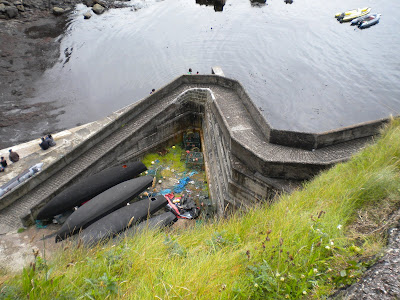The Blasket Islands are a group of islands just west of the Dingle pennisula, the western most point of Ireland. The Great Blasket (An Blascaod Mo'r) is the largest, at about 3 miles long and 1/2 mile wide. The Blaskets were inhabited (two of them) for several hundred years, apparently by some extremely hardy souls-- there is not a tree or a bush to be found. Population declined somewhat during the potato famine of 1845-1851, then rebounded to peak at about 120 with 23 families. (It must have been terribly crowded in these small cottages!) It began to decline after WWII until 1953 when the remaining residents abandoned the island. (Many of the young adults were leaving to go to America, sending home money once established to enable another emigrant to leave. Finally there were too few able bodied souls to sustain life on the island.) Residents made their living by fishing, lobster trapping, and raising a few sheep.
Today most of the buildings on Great Blasket have fallen into ruin-- although one or two are privately owned as "get aways" (?) A small ferry runs every hour from Dunquin (weather permitting), mostly bringing tourists to visit the island.
A visitor center has been built in Dunquin that gives the history and culture of the Blasket Islands, and their residents. Several authors and scholars came to the islands in the early 1900s to rediscover the Irish language and folklore, which had disappeared from much of Ireland, publishing several books.
Dunquin Pier-- This is the pier in Dunquin where the ferry to Great Blasket Island embarks. The pier is in a small inlet at the bottom of a cliff-- quite a climb out. The tides in Ireland are large (it's far north)-- at low tide the ferry cannot come into the pier, and passengers must be transported to/from the pier and ferry by a small Zodiac boat. The ferry passengers must be loaded and unloaded from the ferry using the Zodiac in all tides at Great Blasket, as the pier there is very primitive and small.
The boats on the pier are fishing/lobsterman boats used in this area (for a very long time). They are constructed of wood framing with canvas stretched over it, then tarred. In older days the boats had oars and a small sail. Most of the modern boats have a well to receive a small outboard motor.
Blasket Islands-- Beyond the rock outcropping in the foreground is Great Blasket Island (An Blascasod Mo'r). You can just make out some of the buildings on it (The village). Just to the right, is a low lying island of Beginish (Beiginis). Behind Great Blasket (the bump) is Inishtooksert (Inis Tuaisceart). The photo is taken from the beach area directly next to the Dunquin Pier-- low tide.
Ferry "Blasket Queen"-- Blasket ferry passengers Nate, Elaine and Isabelle headed to the Great Blasket Island on tour
The Great Blasket Island Pier and Port-- This is what served as the "pier" on GBI. There is a something of a concrete ramp where the people are standing, and a rocky incline up to a cable winch (in the foreground, with yellow rope on it). To the right of the people there is a sea wall. We are waiting for the ferry (the LAST ferry of the day!) to come pick us up. Miss the ferry, and you are camping over night.

Blasket Island Ramp-- Looking up from the lower ramp, the upper ramp and path to the GBI pier is merely stone. (You can see the winch and rope from the lower ramp picture here)
Sea Wall-- This sea wall added some protection to the small inlet and boat ramp on GBI. It is about 15 feet tall. It was constructed in the 1920's-- perhaps the unprotected beach was used for landing boats prior to pier and sea wall construction.
Blasket Ruins-- Skeletons of the houses on Blasket Island. The one cottage that is in good shape appears to be under renovation by someone-- perhaps a weekend cottage.
Bunny-- The Great Blasket Island has rabbits and sheep (at least)
Inishvickillane (Inis Mhic Aoibhlea'in)island--, one of the smaller Blaskets has only resident. In the 1970's the Irish government populated the island with red deer. There are now several hundred deer (visible on the ridge) on the island today.
There are five islands in total in the Blasket chain:
Inishtookskert (Inis Tuaisceart)
Beginish (Beiginis) (Great Blasket)
Great Blasket Island (An Blascaod Mo'r)
Inishnabro (Inis naBro')
Inishvickillane (Inis Mhic Aoibhlea'in)









































